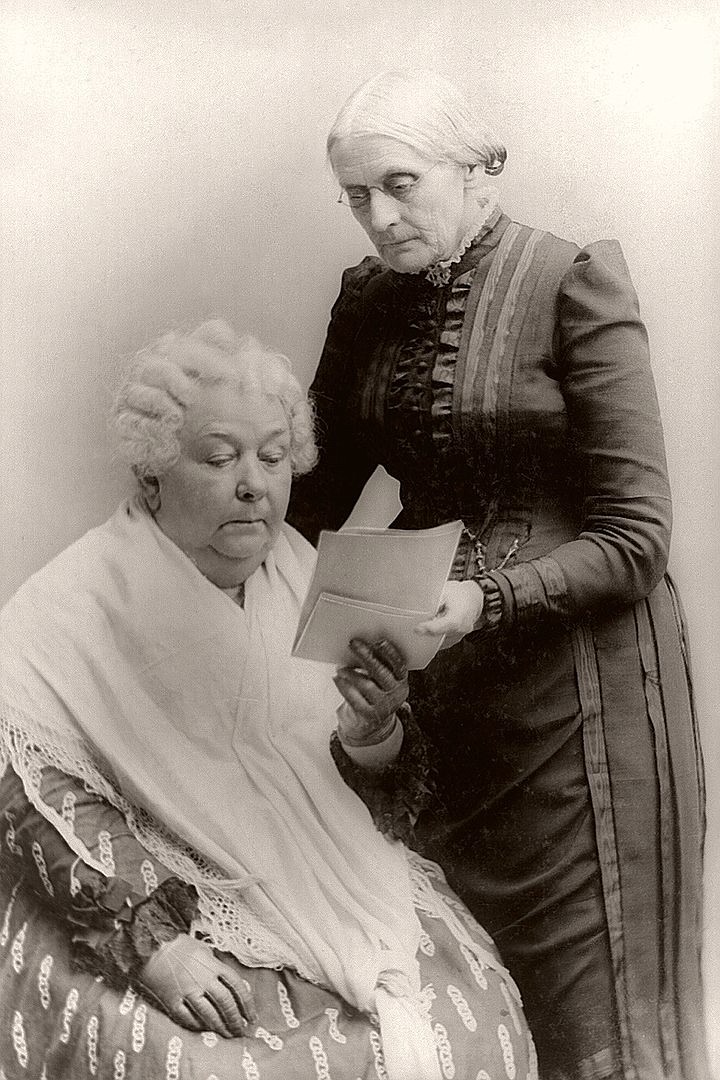Many Americans believe Susan B. Anthony was the first prominent American female to fight for women's rights. The truth is, however, that Elizabeth Cady Stanton was the woman who began the fight as early as 1840.
Elizabeth's father, Daniel Cady, was a prominent Federalist attorney who served one term in the U.S. Congress (18141817) and then became both a circuit court judge and, in 1847, a New York Supreme Court justice. He raised his daughter to be strong and independent and to fight for what she believed.
Elizabeth became an abolitionist and fought for slavery emancipation. Her gender added to the struggle. In 1840, she and Quaker minister Lucretia Mott were both barred from the World Anti-Slavery Convention in London.
She was there for her honeymoon with Henry Brewster Stanton. Henry was a journalist, an antislavery orator and - after his marriage to Elizabeth Cady - an attorney. The couple was married in 1840 with Elizabeth refusing to say the phrase "promise to obey" in the wedding vows, despite Daniel Cady's reservations. She wrote later, "I obstinately refused to obey one with whom I supposed I was entering into an equal relation."
The couple had six children between 1842 and 1856. Their seventh and last child, Robert, was an unplanned baby born in 1859 when Elizabeth Cady Stanton was 44. The marriage lasted for 47 years, ending with Henry's death in 1887.
Stanton asserted that her children were conceived under a program she called "voluntary motherhood." In an era when it was commonly held that a wife must submit to her husband's sexual demands, Stanton firmly believed that women should have command over their sexual relationships and childbearing.
Elizabeth and Lucretia began planning the first Women's Convention in the U.S., which was held in 1848 in Seneca Falls, N.Y. Stanton wrote "The Declaration of Sentiments" that created the agenda of women's activism for decades to come. A year later, the first state constitution in California extended property rights to women.
The Women's Rights Movement picked up momentum over the next few years, and a second National Women's Rights Convention was held in 1851 in Worcester, Mass. Horace Mann and Harry Ward Beecher, one of the nation's most prominent preachers, attended the event. Meanwhile, former slave Sojourner Truth delivered her memorable speech "Ain't I a Woman?" at a convention in Akron, Ohio.
Susan B. Anthony joined the fight in 1853 after she and Antoinette Brown were not allowed to speak at the World's Temperance Convention in New York City. After the Civil War, women's rights efforts picked back up in 1866 as Elizabeth and Susan formed the American Equal Rights Association (ERA), an organization dedicated to the goal of suffrage for all, regardless of gender or race.
While removing herself from the front line of the movement to manage her children and an ailing husband, Elizabeth kept in touch with Susan, and writing Susan's speeches became one of her primary modes of involvement in the movement. Many women of that time, including Susan, remained single because, in the mid-1800s, married women could not own property and could not make legal contracts on their own behalf.
Stanton's tireless public efforts led to her silhouette being engraved on a silver dollar, which debuted in 1979 - more than 100 years after Susan showed up unannounced at Independence Hall in Philadelphia to present the "Declaration of Rights for Women" written by Elizabeth.
While Susan had the time and energy to do the speaking and traveling that Elizabeth was unable to do, their skills complemented each other; Elizabeth, the better orator and writer, scripted many of Susan's speeches, while she was the movement's organizer and tactician. Elizabeth once wrote to her, "No power in heaven, hell or earth can separate us, for our hearts are eternally wedded together."
In 1868, "The Revolution" periodical debuted. Elizabeth and Susan, along with Parker Pillsbury, choose the motto "Men their rights and nothing more; women their rights and nothing less."
The 14th Amendment to the U.S. Constitution, ratified in 1868, granted citizenship to all persons born or naturalized in the United States - including former slaves - and guaranteed all citizens "equal protection of the laws." At the time, "citizens" and "voters" were defined exclusively as male, which caused much controversy in the ERA. Some members were not supportive of the 15th Amendment proposal that would enfranchise black American males while avoiding the question of woman's suffrage entirely.
The next year, 1869, Elizabeth and Susan found the National Woman Suffrage Association (NWSA), based in New York. It was a more radical institution, to achieve the vote through a Constitutional amendment as well as push for other woman's rights issues. Other, more conservative, activists including Lucy Stone, Henry Blackwell and Julia Ward Howe formed the American Woman Suffrage Association (AWSA), based in Boston, to work for women through amending individual state constitutions.
In 1870, the 15th Amendment gave black men the right to vote. NWSA refused to work for its ratification and instead members advocated for a 16th Amendment that would dictate universal suffrage. Frederick Douglass, known as "the father of the civil rights movement," broke with Stanton and Anthony over the position of NWSA.
Over the next 20 years, the movement grew throughout the expanding states. During that time, Susan was arrested, along with 15 others, for illegally voting for Ulysses S. Grant in the 1872 presidential election. She was levied a fine that she never paid. The Woman's Christian Temperance Union (WCTU) was founded by Annie Wittenmyer in 1874, and it helped speed up progress of the movement.
In 1878, A Woman Suffrage Amendment was proposed in the U.S. Congress; 41 years later it is passed as the 19th Amendment. Fast forward to 1887, when the first vote on woman suffrage was defeated in the Senate. The next year, 1888, The National Council of Women in the U.S. was established to promote the advancement of women in society.
After Henry Stanton's death in 1887, Elizabeth returned to the forefront of the movement. The NWSA and AWSA merged in 1890 and formed the National American Woman Suffrage Association to focus on securing suffrage at the state level throughout the U.S. Elizabeth was named its first president. The "Progressive Era" began, with Elizabeth at the helm of the movement she started forming 50 years earlier.
Stanton died of heart failure, at home, on October 26, 1902, at age 87, having written "The Woman's Bible" (1895), her autobiography "Eighty Years and More" (1898) and many articles and pamphlets about female suffrage and women's rights. It would take another 18 years before women were granted the right to vote in the United States.
When writing a tribute that appeared in The New York Times at Elizabeth's death, Susan described her as having "forged the thunderbolts" that she (Susan) "fired." Unlike Anthony's relatively narrow focus on suffrage, Stanton wanted to push for a broader platform of women's rights in general.
While their opposing viewpoints led to some discussion and conflict, no disagreement threatened their friendship or working relationship; the two women remained close friends and colleagues until Stanton's death some 50 years after their initial meeting. While always recognized as movement leaders whose support was sought, Stanton and Anthony's voices were soon joined by others who began assuming leadership positions within the movement.
In 1973, Elizabeth Cady Stanton was inducted into the National Women's Hall of Fame in Seneca Falls, N.Y., where Stanton was among the 300 who gathered there in 1848.
The U.S. Treasury Department announced on April 20, 2016, that an image of Elizabeth would appear on the back of a newly designed $10 bill along with Lucretia Mott, Sojourner Truth, Susan B. Anthony, Alice Paul and the 1913 Woman Suffrage Procession.
Designs for new $5, $10 and $20 bills will be unveiled this year in conjunction with the 100th anniversary of American women winning the right to vote under the 19th Amendment.


